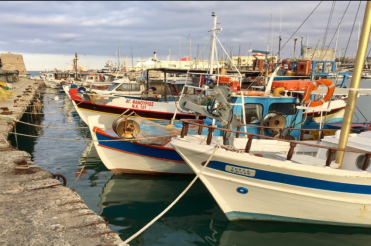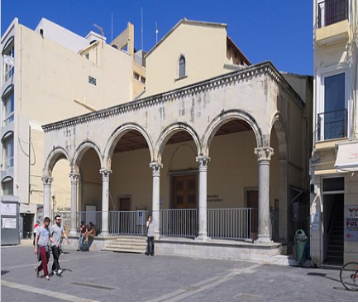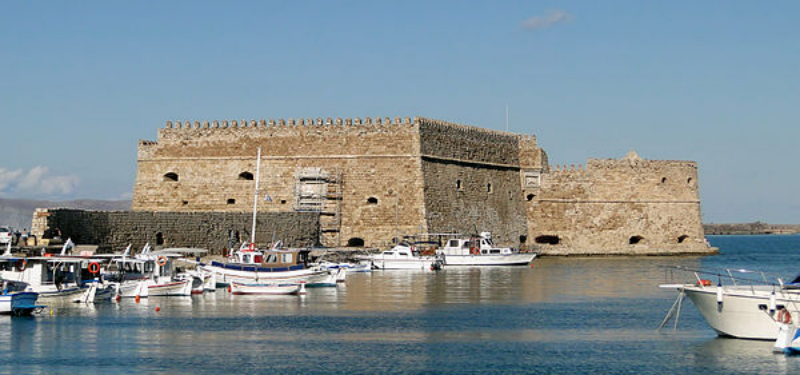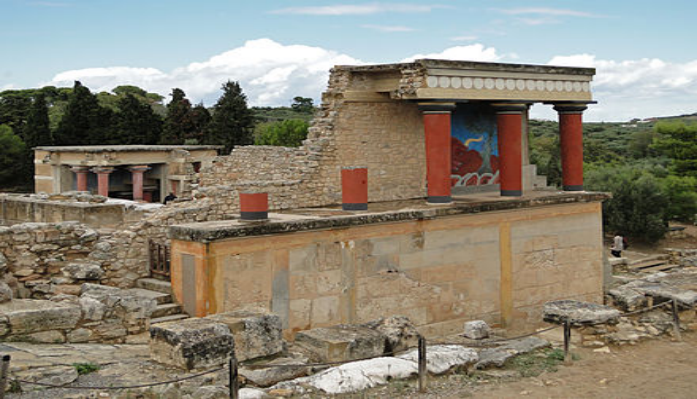Heraklion / Iraklion, Heraklion, Crete 作者: 来源: 发布时间:2021-05-17
I. Population, Area
Total Area: 244.6 km2
Elevation: 33m (108 ft)
Municipal unit density: 710/km2
Population: 211,370 (2011)

II.Natural Geography
lA boisterous port city on the surface, this urban capital of Crete hides millennia of history beneath its modern trappings. In Heraklion, scooters zip past Minoan and medieval relics such as the seaside Koules Fortress, while Turkish fountains bubble up in the shadow of apartment blocks.
Port
Heraklion is an important shipping port and ferry dock. Travellers can take ferries and boats from Heraklion to destinations including Santorini, Ios Island, Paros, Mykonos, and Rhodes. There are direct ferries to Naxos, Karpathos, Kasos, Sitia, Anafi, Chalki and Diafani. There are also several daily ferries to Piraeus, the port of Athens in mainland Greece. The port of Heraklion was built by Sir Robert McAlpine and completed in 1928.
Airport
Heraklion International Airport, or Nikos Kazantzakis Airport is located about 5 kilometres (3 miles) east of the city. The airport is named after Heraklion native Nikos Kazantzakis, a writer and a philosopher. It is the second busiest airport of Greece after Athens International Airport, first in charter flights and the 65th busiest in Europe, because of Crete being a major holiday destination with 7.974.887 travellers in 2018 (List of the busiest airports in Europe).In April 2018, the inner space of the airport has been modernized and expanded by almost 3.000 s.m., with 11 new gates and new stores. The expansion was a donation by Hellenic Duty Free Shops. The airfield is shared with the 126th Combat Group of the Hellenic Air Force. A project for the new airport of Heraklion in Kasteli area is starting at the end of 2017.
Highway Network
European route E75 runs through the city and connects Heraklion with the three other major cities of Crete: Agios Nikolaos, Chania, and Rethymno.
Railway: From 1922 to 1937, there was a working industrial railway, which connected the Koules in Heraklion to Xiropotamos for the construction of the harbor. A study from the year 2000 investigated the feasibility of two tram lines in Heraklion. The first line would link the Stadium to the airport, and the second the center of Heraklion and Knossos. No approval has yet been given for this proposal. In the summer of 2007, at the Congress of Cretan emigrants, held in Heraklion, two qualified engineers, George Nathenas (from Gonies, Malevizi Province) and Vassilis Economopoulos, recommended the development of a railway line in Crete, linking Chania, Rethymno and Heraklion, with a total journey time of 50 minutes (30 minutes between Heraklion and Rethymno, 20 minutes from Chania to Rethymno) and with provision for extensions to Kissamos, Kastelli Pediados (for the planned new airport), and Agios Nikolaos. No plans exist for implementing this idea.

III. ECONOMY
Heraklion was Europe's fastest growing tourism destination for 2017, according to Euromonitor, with an 11.2% growth in international arrivals. According to the ranking, Heraklion was ranked as the 20th most visited region in Europe, as the 66th area on the Planet and as the 2nd in Greece for the year 2017, with 3.2 million visitors and the 19th in Europe for 2018, with 3.4 million visitors.
IV. Attractions
1.Koules Fortress

The Koules or Castello a Mare ("Fort on the Sea" in Italian) is a fortress located at the entrance of the old port of Heraklion, Crete, Greece. It was built by the Republic of Venice in the early 16th century, and is still in good condition today.
The fortress is made up of two parts: a high rectangular section, and a slightly lower semi-elliptical section. Its walls are up to 8.7m thick at some places, and it has three entrances. The fort has two stories, with a total of 26 rooms, which were originally used as barracks, a prison, storage rooms, a water reservoir, a church, a mill and a bakery.
A lighthouse tower is located on the northern part of the fort.
2.Knossos

Knossos (also Cnossos) is the largest Bronze Age archaeological site on Crete and has been called Europe's oldest city.
Settled as early as the Neolithic period, the name Knossos survives from ancient Greek references to the major city of Crete. The palace of Knossos eventually became the ceremonial and political centre of the Minoan civilization and culture. The palace was abandoned at some unknown time at the end of the Late Bronze Age, c. 1,380–1,100 BC. The reason why is unknown, but one of the many disasters that befell the palace is generally put forward.
In the First Palace Period (around 2,000 BC), the urban area reached a size of as many as 18,000 people. In its peak, the palace and surrounding city boasted a population of 100,000 people shortly after 1,700 BC.
V. History
Minoan Era
Heraklion is close to the ruins of the palace of Knossos, which in Minoan times was the largest centre of population on Crete. Knossos had a port at the site of Heraklion (at Poros - Katsambas neighborhood) from the beginning of Early Minoan period (3500 to 2100 BC). Between 1600 and 1525 BC, the port was destroyed by a volcanic tsunami from nearby Santorini, leveling the region and covering it with ash.
Antiquity
Main article: Heracleium
After the fall of the Minoans, Heraklion, as well as the rest of Crete in general, fared poorly, with very little development in the area. Only with the arrival of the Romans did some construction in the area begin, yet especially early into Byzantine times the area was abound with pirates and bandits.
Emirate of Crete
The present city of Heraklion was founded in 824 by the Arabs under Abu Hafs Umar who had been expelled from Al-Andalus by Emir Al-Hakam I and had taken over the island from the Eastern Roman Empire. They built a moat around the city for protection, and named the city rabḍ al-ḫandaq. It became the capital of the Emirate of Crete (ca. 827–961). The Saracens allowed the port to be used as a safe haven for pirates who operated against Imperial (Byzantine) shipping and raided Imperial territory around the Aegean.
Byzantine era
Further information: Byzantine Crete
In 960, Byzantine forces under the command of Nikephoros Phokas, later to become Emperor, landed in Crete and attacked the city. After a prolonged siege, the city fell in March 961. The Saracen inhabitants were slaughtered, the city looted and burned to the ground. Soon rebuilt, the town remained under Byzantine control for the next 243 years.
Venetian era
Further information: Siege of Candia
In 1204, the city was bought by the Republic of Venice as part of a complicated political deal which involved, among other things, the Crusaders of the Fourth Crusade restoring the deposed Eastern Roman Emperor Isaac II Angelus to his throne. The Venetians improved on the ditch of the city by building enormous fortifications, most of which are still in place, including a giant wall, in places up to 40 m thick, with 7 bastions, and a fortress in the harbour. Chandax was renamed Candia and became the seat of the Duke of Candia, and the Venetian administrative district of Crete became known as "Regno di Candia" (Kingdom of Candia). The city retained the name of Candia for centuries and the same name was often used to refer to the whole island of Crete as well. To secure their rule, Venetians began in 1212 to settle families from Venice on Crete. The coexistence of two different cultures and the stimulus of Italian Renaissance led to a flourishing of letters and the arts in Candia and Crete in general, that is today known as the Cretan Renaissance.
Ottoman era
Further information: Cretan War (1645–1669)
During the Cretan War (1645–1669), the Ottomans besieged the city for 21 years, from 1648 to 1669, perhaps the longest siege in history. In its final phase, which lasted for 22 months, 70,000 Turks, 38,000 Cretans and slaves and 29,088 of the city's Christian defenders perished.The Ottoman army under an Albanian grand vizier, Köprülü Fazıl Ahmed Pasha conquered the city in 1669.
Under the Ottomans, Kandiye was the capital of Crete until 1849, when Chania (Hanya) became the capital, and Kandiye became a sancak.In Greek, it was commonly called Megalo Castro .
During the Ottoman period, the harbour silted up, so most shipping shifted to Chania in the west of the island.
Modern era
In 1898, the autonomous Cretan State was created, under Ottoman suzerainty, with Prince George of Greece as its High Commissioner and under international supervision. During the period of direct occupation of the island by the Great Powers (1898–1908), Candia was part of the British zone. At this time, the city was renamed "Heraklion", after the Roman port of Heracleum ("Heracles' city"), whose exact location is unknown.
In 1913, with the rest of Crete, Heraklion was incorporated into the Kingdom of Greece. Heraklion became again capital of Crete in 1971, replacing Chania.
Further information: Fortifications of Heraklion
Venetian constructions such as the Koules Fortress (Castello a Mare), the ramparts and the arsenal dominate the port area.
Several sculptures, statues and busts commemorating significant events and figures of the city's and island's history, like El Greco, Vitsentzos Kornaros, Nikos Kazantzakis and Eleftherios Venizelos can be found around the city.
Many fountains of the Venetian era are preserved, such as the Bembo fountain, the Priuli fountain, Palmeti fountain, Sagredo fountain and Morosini fountain (in Lions Square).
Around the historic city center of Heraklion there are also a series of defensive walls, bastions and other fortifications which were built earlier in the Middle Ages, but were completely rebuilt by the Republic of Venice. The fortifications managed to withstand the longest siege in history for 21 years, before the city fell to the Ottomans in 1669.
VI.Contact Information
Mayor: Labrinos
Address:Agiou Titou 1,
71202, Heraklion, Crete, Greece
Phone: +30-2813-409000
Fax: +30-2810-227180
email: info@heraklion.gr
